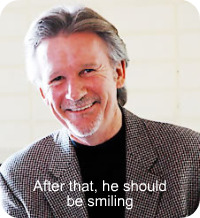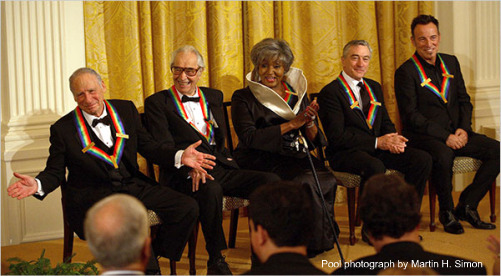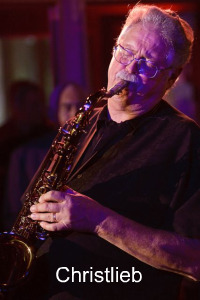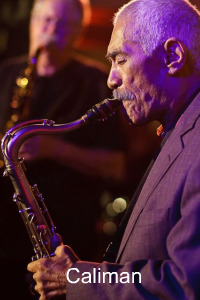Rifftides: December 2009 Archives
2009 brought to the Rifftides doorstep an unprecedented number of albums hoping for attention. If I had listened all day every day this year, I could not have paid proper attention to even a small percentage of them. I have been attempting to catch up with some of the CDs in the stacks that occupy what's left of my floor space (shelves are no longer available). In this series of posts, I will call to your attention a few of them. Some of these items will be not so much reviews as listening suggestions. I won't bother you with music that bores or disappoints me, and I know that I run the risk of overlooking a masterpiece. C'est la vie et à l'écoute.
Plunge, Dancing On Thin Ice (Immersion). Plunge is among the best post-Katrina jazz developments in New Orleans music. In the city's tradition of absorbing, assimilating and combining disparate elements, this unorthodox trio is indeed on thin ice at times, without losing sight of the shore of New Orleans convention. Trombonist Mark McGrain, saxophonist Tim Green and bassist James Singleton are out there with chancy harmonies, elastic time and forays into electronics, but they are also inside the blues and slow-drag feelings of their city. 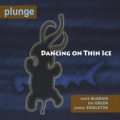 They generate moments reminiscent of music as various as the Jimmy Giuffre trio's folksiness, 1960s free experimentalism, and that long march to the cemetery uptown or out by the lake. This is a lot of music from three people. The deep tones of Singleton's bass are as evocative in Plunge as in Astral Project, the group with which he is most closely associated. He is centered, bold and eager for adventure, as he was when I first heard him in a New Orleans jam session more than thirty years ago. In McGrain and Green, Singleton has kindred spirits.
They generate moments reminiscent of music as various as the Jimmy Giuffre trio's folksiness, 1960s free experimentalism, and that long march to the cemetery uptown or out by the lake. This is a lot of music from three people. The deep tones of Singleton's bass are as evocative in Plunge as in Astral Project, the group with which he is most closely associated. He is centered, bold and eager for adventure, as he was when I first heard him in a New Orleans jam session more than thirty years ago. In McGrain and Green, Singleton has kindred spirits.
Svend Asmussen, Rhythm Is Our Business (Storyville). Svend Asmussen, Makin' Whoopee...And Music (Arbors).
Asmussen turned 93 three days ago. He is not as overtly astonishing a violinist in the Arbors CD recorded this year as he was when he made the tracks in the Storyville compilation in 1953 and 1958. He is a deeper one. In the reissue, the novelty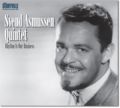 recordings that helped make him a Danish national figure include a couple of his vocals that are discomforting on grounds of taste ("Carry Me Back To Old Virginny") or execution (his rush through "Darktown Strutters Ball"), but there is little of that. His playing is impeccable throughout and in several places palpably exciting. He has two exquisite duets with guitarist Ulrik Neumann.
recordings that helped make him a Danish national figure include a couple of his vocals that are discomforting on grounds of taste ("Carry Me Back To Old Virginny") or execution (his rush through "Darktown Strutters Ball"), but there is little of that. His playing is impeccable throughout and in several places palpably exciting. He has two exquisite duets with guitarist Ulrik Neumann.
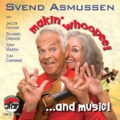 On Makin' Whoopee, if the nonagenerian Asmussen is less acrobatic than his 45-year-old self and slightly less sure of bow, his tone is darker, his expressiveness deeper, his celebrated harmonic sense intact and his swing steady. Highlights: his samba called "Fiddler in Rio," a gorgeous reading of Django Reinhardt's "Nuages" and a swaggering solo in Ellington's "Things Ain't What They Used to Be." Among his accompanists, pianist Richard Drexler and Asmussen's longtime guitarist Jacob Fischer are superb.
On Makin' Whoopee, if the nonagenerian Asmussen is less acrobatic than his 45-year-old self and slightly less sure of bow, his tone is darker, his expressiveness deeper, his celebrated harmonic sense intact and his swing steady. Highlights: his samba called "Fiddler in Rio," a gorgeous reading of Django Reinhardt's "Nuages" and a swaggering solo in Ellington's "Things Ain't What They Used to Be." Among his accompanists, pianist Richard Drexler and Asmussen's longtime guitarist Jacob Fischer are superb.
Ithamara Koorax & Juarez Moreira, Bim Bom: The Complete João Gilberto Songbook (Motéma). Gilberto's influence on Brazilian and much of the other music of our time has been pervasive for half a century. Yet, his repertoire primarily consists of songs composed by others, most prominently Antonio Carlos Jobim. In the development of modern samba Jobim was to Gilberto as Dizzy Gillespie said Charlie Parker was to him in bebop, the other half of his heartbeat. Gilberto has written only 11 songs, most of them less familiar than "Bim Bom," each of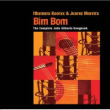 them exquisite in its own way. This gem of an album by the Brazilian singer Ithamara Koorax and guitarist Juarez Moreira gathers all of Gilberto's songs under one cover for the first time. Gilberto himself has never done that. The purity and tonal accuracy of Koorax's voice, the perfection of her phrasing and interpretation, beautifully serve the songs in ways that should delight the composer. Moreira accompanies her with subtlety and harmonic resourcefulness that suggest Gilberto's own guitar playing. He has two tracks to himself. You may be familiar with "Bim Bom," "Hô-Bá-Lá-Lá" and "Minha Saudade," but unless you're a Gilberto completist, "Vôce Esteve Com Meu Bem?" "Bebel" and the others may be new to you. Koorax and Moreira are a fine way to meet them. Early in the collection, Koorax sings "Hô-Bá-Lá-Lá" in Portuguese and later, in a separate track, in flawlessly unaccented English. I'd be hard-pressed to say which is the more charming.
them exquisite in its own way. This gem of an album by the Brazilian singer Ithamara Koorax and guitarist Juarez Moreira gathers all of Gilberto's songs under one cover for the first time. Gilberto himself has never done that. The purity and tonal accuracy of Koorax's voice, the perfection of her phrasing and interpretation, beautifully serve the songs in ways that should delight the composer. Moreira accompanies her with subtlety and harmonic resourcefulness that suggest Gilberto's own guitar playing. He has two tracks to himself. You may be familiar with "Bim Bom," "Hô-Bá-Lá-Lá" and "Minha Saudade," but unless you're a Gilberto completist, "Vôce Esteve Com Meu Bem?" "Bebel" and the others may be new to you. Koorax and Moreira are a fine way to meet them. Early in the collection, Koorax sings "Hô-Bá-Lá-Lá" in Portuguese and later, in a separate track, in flawlessly unaccented English. I'd be hard-pressed to say which is the more charming.
This seems to be the week for unexpected videos to materialize. In the piece highlighted in the previous exhibit, Jack Berry joined me in lamenting that we could find no evidence of Vince Guaraldi on film or tape. Jazz writer Ken Dryden came to the rescue this morning with a reminder that Guaraldi's trio backed Jimmy Witherspoon and Ben Webster in a 1962 episode of Ralph J. Gleason's Jazz Casual program on PBS. Here are two excerpts recalling one of the great singer-instrumentalist partnerships. There is no Guaraldi solo, but superb accompaniment by him, drummer Colin Bailey and a bassist hidden behind Witherspoon who is most likely Monty Budwig.
The Witherspoon-Webster encounter is available on a DVD with another Jazz Casual show devoted to Jimmy Rushing.
And here is Guaraldi finally getting to solo. This is a latterday version of the piece that twenty years earlier had made Webster famous when he was with Duke Ellington.
The recent reissue of music by Vince Guaraldi and subsequent Rifftides and radio ramblings led the veteran print and broadcast journalist Jack Berry to grace a new web site with an account of a piquant Guaraldi adventure. It has to do with Vince's ability to make lemonade.
When he climbed up on the bench and began his first tune, however,something ominous occurred. There was an entirely dead note on the piano. Guaraldi halted the song and looked into the middle distance with an expression of deep bemusement.
"Here's trouble," I predicted to Ms. Hoffman.Guaraldi tapped the dead note, tentatively at first, then with increasing violence. THUNK, THUNK, THUNK. Dropping his head, he thought for a moment, then began gently tapping the conspicuously expired key.
To read all of Berry's piece, go to Oregon Music News. It is good to know that he will be contributing often to that site.

When Terry Pollard died the other day, I scoured the internet in hopes of finding video of her playing. I had no luck. But moments ago, Mark Stryker of The Detroit Free Press notified me that a clip has appeared on YouTube of the pianist in Terry Gibbs's quartet on The Tonight Show in 1956. They play "Gibberish," on the harmonic pattern of "Oh, Lady Be Good," then a riotous vibes duet on the Charlie Parker blues "Now's The Time" with Tonight Show host Steve Allen accompanying on piano. This is an unexpected treasure.
In his accompanying e-mail, Stryker asks:
... while her piano playing is really out of Bud, after watching the clip a couple times, I hear some similarities with early Horace Silver in the pinging evenness of her articulation, the blues allusions and the rumble in her left hand. Do you hear this or am I imagining -- Blue Note trio Horace, when he was still playing long 8th note lines, before he distilled his right hand into short, jabbing ideas.
Yes, and I detect in Pollard's work another derivative of Bud Powell's influence, that of Hampton Hawes. Pollard spent some time with Gibbs on the west coast when Hawes was at his peak.
But, influences, schminfluences; she was an original.
Pollard's only album as a leader was a 10-inch vinyl LP on the Bethlehem label, 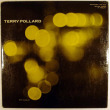 recorded in 1955, less than a year before the Tonight Show
recorded in 1955, less than a year before the Tonight Show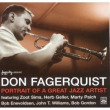 appearance. Her quintet included guitarist Howard Roberts and the brilliant trumpter Don Fagerquist. It was never reissued on a 12" LP, much less on a CD. The 10-incher shows up on e-Bay and other web sites as an expensive auction item. But three tracks of the Terry Pollard LP are included on this CD compilation of performances by Fagerquist, who died in 1974 at the age of 46.
appearance. Her quintet included guitarist Howard Roberts and the brilliant trumpter Don Fagerquist. It was never reissued on a 12" LP, much less on a CD. The 10-incher shows up on e-Bay and other web sites as an expensive auction item. But three tracks of the Terry Pollard LP are included on this CD compilation of performances by Fagerquist, who died in 1974 at the age of 46.
San Francisco's Company C Contemporary ballet company includes this item in the announcement of its spring season.
Charles Anderson, Beautiful Maladies Music by: Richard Rogers and Lorenz Hart, Hoagy Carmichael, George Benson and others Arranged and performed by: Chet Baker
Expanded from last season's You Don't Know What Love Is, Charles Anderson's Beautiful Maladies, is set to seven exquisite ballads arranged and sung by West Coast Jazz legend Chet Baker. Enveloped by Baker's silky smooth sounds, this dramatic ballet's lush, sensuous movement and saturated colors carry us on an emotional journey through the complexities of love.
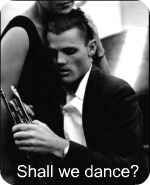
For details, go here.
Two year after he took over the Isham Jones band, Woody Herman had infused it with his personality and leadership. We see and hear evidence in this piece from a film short made in 1938. It may seem a quaint choice of material, but in the late thirties, King Oliver's "Doctor Jazz" was still a minor staple in the repertoires of groups small and large. This is the polished pre-Herd Herman enjoying a novelty piece that he had recorded for Decca.
Terry Pollard was a gifted pianist whose ability paralleled that of her fellow Detroiters Tommy Flanagan and Barry Harris. She shared their grasp of the bebop vocabulary and, some admirers claimed, swung even harder. I became aware of her when she recorded with the vibraharpist Terry Gibbs in the early 1950s. She is with Gibbs on this album, one of her few recordings. In the picture below, which I pirated from the photo section of Bill Crow's web site, Ms. Pollard is at Birdland with Gibbs, Crow and drummer Frank Di Vito.
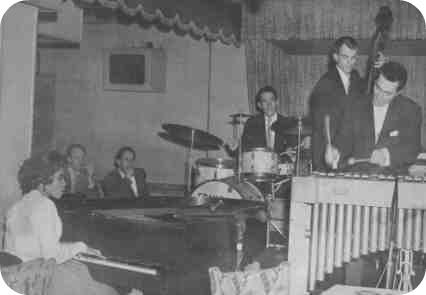
For more on Terry Pollard, see Mark Stryker's column in today's Detroit Free Press.
I yield to no one in my admiration for Bob Brookmeyer, but Darcy James Argue gives me a good run for my money. Brookmeyer, the ground-breaking composer, arranger, leader and nonpareil valve trombone soloist, entered his ninth decade this week. Early in December, the Eastman School of Music honored him for his lifetime of achievement and he sat in with the students there. I cannot improve on the eloquence about Brookmeyer in Argue's Secret Society web log. A sample:
Brookmeyer is one of the greatest living composers, full stop -- that's nothyperbole, that's just how it is. He is also a tremendous soloist on valve trombone (Bob gave up the slide instrument at the earliest opportunity). His swing feeling is unstoppable and as authentic as it gets: he grew up in Kansas City in the 1930's, and first heard the legendary Walter Page-Jo Jones edition of the Count Basie band live when he was all of eleven years old. (Bob says the experience "gave me my first full-body thrill.") He is a true improviser, never reliant on stock licks or patterns, and is consistently inventive and surprising even on the most timeworn standards.
Argue includes five MP3 playbacks of some of Brookmeyer's best big band work. He links to several other tributes and evaluations and to Brookmeyer's own account of the Eastman event. To read -- and listen to -- the whole thing, go here.
Congratulations to Darcy on a fine installment, and happy birthday to Bob Brookmeyer, an American cultural treasure cherished abroad and overdue for official recognition by his country.
"Open Country" is one of Bob Brookmeyer's notable compositions from the 1950s. Here, he plays it with Gerry Mulligan in Mulligan's quartet. Wyatt "Bull" Ruther is the bassist, Gus Johnson the drummer/
Bill Mays, Mays at the Movies (Steeplechase). The pianist is a veteran of motion picture sound 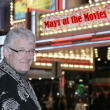 stages, but in this stimulating trio session he's free from click tracks, conductors and scores. With bassist Peter Washington and drummer Billy Drummond, Mays interprets nine pieces from films as disparate as Cocoanut Grove (1938) and Burn After Reading (2008). Highlights: his thorough exploration of the love theme from 'Spartacus;" the dazzling succession of key changes on "I've Never Been in Love Before," in 5/4 time; the inventiveness in his multifaceted composition "Judy;" his interaction with Washington on "The Summer Knows;" Drummond's cymbal splashes in "Charade." Mays sings "You Leave Me Breathless" at least as well as Fred McMurray did in Cocoanut Grove, and personalizes the harmonic changes of that beautiful, neglected song.
stages, but in this stimulating trio session he's free from click tracks, conductors and scores. With bassist Peter Washington and drummer Billy Drummond, Mays interprets nine pieces from films as disparate as Cocoanut Grove (1938) and Burn After Reading (2008). Highlights: his thorough exploration of the love theme from 'Spartacus;" the dazzling succession of key changes on "I've Never Been in Love Before," in 5/4 time; the inventiveness in his multifaceted composition "Judy;" his interaction with Washington on "The Summer Knows;" Drummond's cymbal splashes in "Charade." Mays sings "You Leave Me Breathless" at least as well as Fred McMurray did in Cocoanut Grove, and personalizes the harmonic changes of that beautiful, neglected song.
James Weidman, Three Worlds (Inner Circle). No doubt because he has devoted much of his career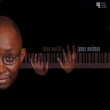 to accompanying singers, pianist Weidman's public image lags behind his talent and his respect in the jazz community. His stunning work with Joe Lovano (mentioned here) has helped to bring him to wider attention. This intriguing album may do more. The quintet pieces with reedman Marty Ehrlich and the shaggy-dog trombone of Ray Anderson are the most spectacular and entertaining, but Weidman's work in trio and quartet settings is equally riveting for his touch, solo construction and rhythmic chance-taking. As in Lovano's band, Weidman and drummer Francisco Mela have a symbiotic relationship that may arise from ESP. All of the compositions are Weidman's but "Joshua Fit De Battle of Jericho," which lends itself nicely to an adventurous treatment by Weidman, Mela and bassist Brad Jones.
to accompanying singers, pianist Weidman's public image lags behind his talent and his respect in the jazz community. His stunning work with Joe Lovano (mentioned here) has helped to bring him to wider attention. This intriguing album may do more. The quintet pieces with reedman Marty Ehrlich and the shaggy-dog trombone of Ray Anderson are the most spectacular and entertaining, but Weidman's work in trio and quartet settings is equally riveting for his touch, solo construction and rhythmic chance-taking. As in Lovano's band, Weidman and drummer Francisco Mela have a symbiotic relationship that may arise from ESP. All of the compositions are Weidman's but "Joshua Fit De Battle of Jericho," which lends itself nicely to an adventurous treatment by Weidman, Mela and bassist Brad Jones.
Anne Drummond, Like Water (ObliqSound). After Drummond moved from Seattle to New York 10 years ago to study, pianist Kenny Barron, one of her teachers, was so impressed with 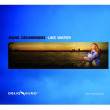 her flute playing that he recruited her for his group Canta Brasil. Her first recording as a leader testifies to impressive development. The lightness, firmness and tonal exactness of her sound combine in this delightful recital with a feeling for the rhythmic and harmonic subtleties of post-bossa nova Brazilian music. Drummond's arrangements and compositions for a chamber ensemble including violin and cello indicate a mature writing talent. The veteran Brazilians Nilson Matta on bass and drummer Duduka Da Fonseca are among the supporting cast. The pianist, impressive accompanying and soloing, is Klaus Mueller, except on one track with the always satisfying Xavier Davis
her flute playing that he recruited her for his group Canta Brasil. Her first recording as a leader testifies to impressive development. The lightness, firmness and tonal exactness of her sound combine in this delightful recital with a feeling for the rhythmic and harmonic subtleties of post-bossa nova Brazilian music. Drummond's arrangements and compositions for a chamber ensemble including violin and cello indicate a mature writing talent. The veteran Brazilians Nilson Matta on bass and drummer Duduka Da Fonseca are among the supporting cast. The pianist, impressive accompanying and soloing, is Klaus Mueller, except on one track with the always satisfying Xavier Davis
At the conclusion of the previous post, Crow's Names, I wrote:
And that, unless a name shows up that reduces the staff to uncontrollable laughter or stunned admiration, ends this exercise in punditry.
Alan Broadbent met not one but both requirements. Say it aloud.
Darrell, Neville, Bea and Arthur Hugh
The Rifftides staff is pleased that the eminent bassist, raconteur and author Bill Crow reads the blog. Among his many activities, Mr. Crow writes the Band Room column in New York AFM Local 802's Allegro monthly publication. Every now and then he contributes a Rifftides comment.  Bill's latest communiqué is in response to the Freddie Schreiber item in the following exhibit. It deserves wider exposure than it might get as a comment to that piece. I have taken the liberty of removing from his list names that duplicate those on Schreiber's. Again, these names are best read aloud and not in the presence of those who fail to understand that, contrary to conventional wisdom, puns are the highest form of humor.
Bill's latest communiqué is in response to the Freddie Schreiber item in the following exhibit. It deserves wider exposure than it might get as a comment to that piece. I have taken the liberty of removing from his list names that duplicate those on Schreiber's. Again, these names are best read aloud and not in the presence of those who fail to understand that, contrary to conventional wisdom, puns are the highest form of humor.
Musicians have been playing the name game for a long time, and I have no idea who started it, but back in April 1983 I ran a lot of names in the fourth column I wrote for Local 802's Allegro, using a list I had gotten from trombonist Jack Gale, and adding some of my own inventions. Jack had collected his list from the Broadway show pits, where a lot of inventive people while away the minutes between musical numbers with word games, jokes, cartoons, etc. Funny ideas travel fast around the music world, and I imagine some of these came from Freddie. Here's Jack's list:
Leader: Owen Guys
Vocalist: Rachel Prejudice
Trumpets: Kenny Makit, Diz Astor, Kent Reed, Noah Count
Bones: Hy Register, Slip Shod, Willie Show
Saxes: Les Tone, Don Swing, Al Thumbs
Percussion: Phil Din, Chick Boom and Perry Diddle
Guitar: Django Bells
Banjo: Ricky Tick
Harp: Anne Dante
Organ: Page Turner
Tuba: Sue Saphon
French Horn: Belle Tone
Vibes: Hal Mallet
Violins: Vi Bratto, Fay Kerr,
Viola: Vera Sharp
Cello: Beau Braker
Harpsichord: Aaron Variations
Asst. Conductor: Justin Case
Arranger: Walt Smedley
Copyist: L. Egible
Librarian: Miss Inga Page
Manager: Hiram Cheep
Band Boy: Manuel Labor
Agent: Gig Booker
Fan Club President: Doug DeBan
The ones I thought up were:Trumpets: Al Tayket, Val Voyle, "Miles" Awai, "Diz" Lexia
Reeds: Reed Fleichit, Harlan Nocturne, Barry DeMelody, Chu Bertalli, Buddy Ansole, Rocco Caine
Bones: Amos B. Haven, Duncan Drisordley, Axel B. Hocht, Albie Laight
Tuba: Erasmus B. Dragon
Piano: "Changes" Kahn
Guitar: Acupulco Gold
Fender Bass: Basil Affendia
Drums: Burr Rumpum
Arranger: Kent Wright
Copyist: Don DeHatch
Sound Man: Hamp LeFeyer
Manager: Noah D'Vance
Conductor: Yul C. Sordplay
Asst. Conductor: Flayling Wilder
Vocalist: Wanda Lust
The guys on NPR's Car Talk always come up with good names for their closing credits, like the attorneys Dewey, Cheatum and Howe. It's a great game, and I'm glad to have Freddie's list to add to my collection.
Click and Clack, the NPR car guys, have a chauffeur name Pickup Andropov.
And that, unless a name shows up that reduces the staff to uncontrollable laughter or stunned admiration, ends this exercise in punditry.
If you a follower of the occasional Rifftides discussions about the music and wit of the late bassist Freddie Schreiber, you know that his inventiveness overlapped into name creation. Dean Reilly, the San Francisco bassist who is an admirer of Schreiber on all fronts, provided what appears to be an authentic list of some of the names Freddie invented. Schreiber's original names inspired imitations that can be found on many web sites. For now, we confine ourselves to a few from the, uh, Dean's list. Say them aloud.
Trumpets:
Kenny Hackett
Willie Cuttett
Kent Makitt
Howie Wales
Al Tissimo
Trombones:
Lew Slips
Andy Bluett
Slide Downs
Saxophones:
Otto Tune
Manny Notes
Felix Cited
Justin Hale
Rhythm:
Thelonious Galantown
R. Peggio
Rad McHugh
Pete Zicatto
Vocalists:
Sonia Papermoon
Haddie Knownbettor
Chester Gigolo
Hugh Jassle
Carrie Mace
Myra Mance
Groupies:
Freda Slaves
Sybil Reitz
Manuel Lehbah
Marsha Dymes
Barbara Seville
Jim Nasium
Isaac Cited
Tyrone Shoelace
Various:
Hiram Cheap -- agent
Arturo Verceez -- booker
Sacha Deal -- booker
Oliver DeRhode -- driver
Randolph A. Cliff -- backup driver
I had never heard of Chris Dawson until this morning, when a link to a video showed up in a friend's e-mail message. The message contained rave blurbs about Dawson from Alan Broadbent, Charlie Haden, Dave Frishberg, Dick Hyman, Gary Foster, John Clayton and Bob Sheppard. The endorsements got my attention. The video was a shortened version of a longer film story about a pianist's miraculous recovery from a hand injury that had ended his playing and put him on the street.
In the clip, Dawson was riveting, with piano work combining stride and bebop. Many latter-day forays into stride end up sounding imitative and automated. Naturalness, ease, harmonic flexibility and a gift for melodic line give his playing authenticity. I must confess that I was also taken with scenes of my old Southern California stomping grounds in the San Fernando Valley and along the Pacific Coast Highway. But the playing is the thing, as you will see and hear in this unedited clip of the film. It may win no Academy Award for acting or direction, but the premise is charming. It runs a little over six minutes.
Evidently, Dawson has been making waves in the Los Angeles area for some time, and has also worked in New York, but he had escaped me. I'm glad to have encountered him. Dawson's web site has biographical information--however sketchy--about this stealth pianist, and more video clips.
The first snowfall of the season is on the ground. This was the morning view from an upstairs bedroom.

That gives me a reason, though none is required, to bring you the original recording of "Snowfall" by Claude Thornhill and his orchestra. Thornhill composed and arranged the song. The recording is from 1941, shortly after he formed his band. The photo montage looks as if it could be from the same period.
For a brief history and discography of Claude Thornhill, go here. "Snowfall" and several of the pieces arranged by Gil Evans that led to what we now call the birth of the cool are on this CD. Note that the list price is astronomical but the used copies are bargains.
My intention was to create something new and arresting, an orchestra different from others on the scene - I wrote sixty arrangements to start with.
We rehearsed every afternoon, rain or shine. Perfect intonations in the sections and balance of the overall sound of the orchestra were emphasized.
With the exception of certain places in our arrangements, the orchestra played without vibrato. Vibrato was used to heighten expressiveness.
It seems to me that touch and tone are pretty much overlooked by pianists who are leading bands nowadays. You can get so many more and better musical effects if you pay attention to those little, shall I say, niceties.
What do Jeremy Eichler and I have in common? We are out of room for the thousands  of CDs that show up when you commit music criticism. Eichler is the classical music critic of The Boston Globe. Some time ago, I wrote about a temporary solution that I applied to the problem of limited shelf space. Eichler has taken a more drastic step. He is putting his collection where the only space consideration is the capacity of his hard drive. His article in today's Globe begins:
of CDs that show up when you commit music criticism. Eichler is the classical music critic of The Boston Globe. Some time ago, I wrote about a temporary solution that I applied to the problem of limited shelf space. Eichler has taken a more drastic step. He is putting his collection where the only space consideration is the capacity of his hard drive. His article in today's Globe begins:
Piles of CDs surround me. I have been feeding them into my computer to suck the music out of them. And then I pack them away.
Further along in the piece, Eichler laments the psychic loss when he consigns music to a realm where tangible evidence of its existence cannot follow.
To begin with, there is nothing left to hold in our hands. Recordings have of course always been physical objects, ever since the first known recording device, a phonautograph, was created in France in the mid-1800s. Its inventor did not design it to play back a song - he could not conceive of such a thing - but merely to visualize the music as lines on paper. Before we could dream of reproducing sound, we simply wanted to hold it.
And still do. A recording documents the presence of musicians who are no longer there, but the thing itself can stand in for them, can mediate our relationship to the music we are hearing. We like to turn it over, gaze at the cover art, devour its liner notes, and arrange it on a shelf in a way that gives it meaning in the context of the other albums we own.
To read all of Eichler's piece, go here. And if you decide to follow his lead, be sure that your computer has a reliable backup system.
In the center column, slightly south, you will find the latest Rifftides recommendations in Doug's Picks. We suggest two new CDs, an imperishable 50-year-old recording, a DVD of a blistering big band and a book held over from last time because reading hours have been few and far between around here lately and I'm not going to pretend I've read something I haven't.
Enjoy.
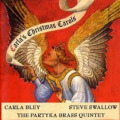 Carla Bley, Steve Swallow, The Partyka Brass Quintet, Carla's Christmas Carols (Watt). Bley arranges nine classic carols with tenderness, wit, harmonic brilliance, wide dynamic range and a wry sense of nostalgia. She adds two of her own pieces, the gorgeous "Jesus Maria" and "Hell's Bells", a joyous concoction on "I Got Rhythm" changes. Swallow's bass work, as always, is perfection. Prepare to be captivated by the brass ensemble and by the solos of trombonist Adrian Mears, trumpeter Axel Schlosser and hornist Christine Chapman.
Carla Bley, Steve Swallow, The Partyka Brass Quintet, Carla's Christmas Carols (Watt). Bley arranges nine classic carols with tenderness, wit, harmonic brilliance, wide dynamic range and a wry sense of nostalgia. She adds two of her own pieces, the gorgeous "Jesus Maria" and "Hell's Bells", a joyous concoction on "I Got Rhythm" changes. Swallow's bass work, as always, is perfection. Prepare to be captivated by the brass ensemble and by the solos of trombonist Adrian Mears, trumpeter Axel Schlosser and hornist Christine Chapman.
On the Jazzhouse web site, W. Royal Stokes posts a valuable column recommending recent jazz, blues and pop photography and art books. It is an extensive list, just in time for Christmas. Stokes gives each book a thorough paragraph of review and a link to an online source for purchase. Here is some of what he writes about Hank O'Neal's Ghosts of Harlem, a recent Doug's Pick:
That he shot them with an ancient wooden view camera, setting up lights, inserting a plate, and throwing a cloth over his head and the instrument (shades of Matthew Brady!) says much about his determination to capture that "moment of truth" in the best possible light. Which he did in image after image.
I was surprised and pleased to find that Mr. Stokes included Take Five: The Public and Private Lives of Paul Desmond despite its being a biography, not a picture book. Now I am even happier that the publisher insisted on lots of photographs.
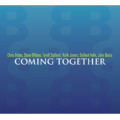 Chris Potter, Steve Wilson, Terrell Stafford, Coming Together (Inarhyme). This was to have been the recording debut in 2005 of the young tenor saxophonist Brendan Romaneck. That year he died at 24 in a traffic accident. In his memory, saxophonists Potter and Wilson, trumpeter Stafford and a fine rhythm section completed the project. Eight of the compositions are Romaneck's. Three are standard songs. Potter is compelling with a pianoless trio on "My Shining Hour." Wilson and Stafford shine on Romaneck's daring "Minion." Pianist Keith Javors, bassist Delbert Felix and drummer John Davis are strong throughout.
Chris Potter, Steve Wilson, Terrell Stafford, Coming Together (Inarhyme). This was to have been the recording debut in 2005 of the young tenor saxophonist Brendan Romaneck. That year he died at 24 in a traffic accident. In his memory, saxophonists Potter and Wilson, trumpeter Stafford and a fine rhythm section completed the project. Eight of the compositions are Romaneck's. Three are standard songs. Potter is compelling with a pianoless trio on "My Shining Hour." Wilson and Stafford shine on Romaneck's daring "Minion." Pianist Keith Javors, bassist Delbert Felix and drummer John Davis are strong throughout.
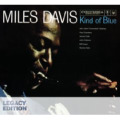 Miles Davis, Kind of Blue (Columbia). Okay, this is the zillionth reissue, and it's not the first to include alternate takes, false starts or a second CD of performances by the classic Davis sextet. The difference? Columbia got the sound right - no forced reverberation, echo, clipping, compression or other digital-age engineering cuteness. This is how the music should sound. Nice packaging, too, retaining the original cover on a sturdy three-panel fold-out box. If you don't own Kind of Blue, this is the one. If you do, the improved sonics are worth considering.
Miles Davis, Kind of Blue (Columbia). Okay, this is the zillionth reissue, and it's not the first to include alternate takes, false starts or a second CD of performances by the classic Davis sextet. The difference? Columbia got the sound right - no forced reverberation, echo, clipping, compression or other digital-age engineering cuteness. This is how the music should sound. Nice packaging, too, retaining the original cover on a sturdy three-panel fold-out box. If you don't own Kind of Blue, this is the one. If you do, the improved sonics are worth considering.
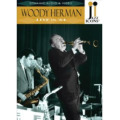 Woody Herman, Live in '64 (Jazz Icons). This captures Herman on British television long after he stopped naming or numbering his Herds. It was one his most exciting bands, driven by drummer Jake Hanna and bassist Chuck Andrus. Upstate New York terrors Joe Romano and Sal Nistico are fascinating in their contrasting tenor sax styles. Two underrated trumpet soloists, Paul Fontaine and Billy Hunt, stand out, as does trombonist Phil Wilson, a master of high-note eloquence. But it's the tout ensemble that grabs you. Woody is charming in his set-piece introductions. BBC sound and video quality are good.
Woody Herman, Live in '64 (Jazz Icons). This captures Herman on British television long after he stopped naming or numbering his Herds. It was one his most exciting bands, driven by drummer Jake Hanna and bassist Chuck Andrus. Upstate New York terrors Joe Romano and Sal Nistico are fascinating in their contrasting tenor sax styles. Two underrated trumpet soloists, Paul Fontaine and Billy Hunt, stand out, as does trombonist Phil Wilson, a master of high-note eloquence. But it's the tout ensemble that grabs you. Woody is charming in his set-piece introductions. BBC sound and video quality are good.
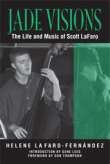 Helene La Faro-Fernández, Jade Visions: The Life and Music of Scott La Faro (North Texas). There will be other books about the most important young bassist of the last half of the twentieth century. Their authors will mine this invaluable first biography. The insight La Faro's sister gives into his character, musicality and determination could come only from someone so close. But the book is not just memories. La Faro-Fernández conducted dozens of interviews and did meticulous research to create a full portrait of the man who in a tragically short career changed jazz bass playing.
Helene La Faro-Fernández, Jade Visions: The Life and Music of Scott La Faro (North Texas). There will be other books about the most important young bassist of the last half of the twentieth century. Their authors will mine this invaluable first biography. The insight La Faro's sister gives into his character, musicality and determination could come only from someone so close. But the book is not just memories. La Faro-Fernández conducted dozens of interviews and did meticulous research to create a full portrait of the man who in a tragically short career changed jazz bass playing.
Thanks to Bill Royston for calling our attention to a strange turn of events at a jazz festival in Spain. Here is beginning of The Guardian's story about the incident:
Jazzman Larry Ochs has seen many things during 40 years playing his saxophone around the world but, until this week, nobody had ever called the police on him.
That changed on Monday night however, when's Spain's pistol-carrying Civil Guard police force descended on the Sigüenza Jazz festival to investigate allegations that Ochs's music was not, well, jazz.Police decided to investigate after an angry jazz buff complained that the Larry Ochs Sax and Drumming Core group was on the wrong side of a line dividing jazz from contemporary music.
The jazz purist claimed his doctor had warned it was "psychologically inadvisable" for him to listen to anything that could be mistaken for mere contemporary music.
To read the whole thing, go here.
This raises the perpetual question, "What is jazz?" and gives a perfect excuse to once again provide Sid Caesar's attempt to answer it.
That nearly subliminal face at the end was Carl Reiner's. He doesn't know, either.
The Kennedy Center Honors ceremony held last Sunday will be televised on CBS December 29. In the meantime, the White House has released a clip of President Obama's informal talk at the reception before the event. It runs about 18 minutes, with the camera on the President the whole time. The following video, nicely edited and produced, incorporates a shortened version of his remarks and interaction with the honorees, Dave Brubeck, Mel Brooks, Grace Bumbry, Robert De Niro and Bruce Springsteen. I thought you would find it interesting.
(When the video ends, it goes to black and hangs there, evidently forever. That's how the White House provided it. If you click on your "reload" symbol in the address bar at the top of your screen, it goes back to normal.)
It was six degrees above zero here last night, but the calendar says we have eleven more days until winter. Before autumn leaves, let's enjoy Bill Evans playing his signature arrangement of one of his favorite pieces. This was Copenhagen in 1965, with Eddie Gomez on bass and Alex Riel playing drums. There are several videos of Evans playing the song, but this one comes closest to the spirit of the version he first recorded in Portrait In Jazz, the 1959 album that brought him to wider attention and critical acclaim.
Indiana Public Media's Night Lights has posted on the internet a one-hour program about Vince Guaraldi. The host, David Brent Johnson, traces the pianist's career, plays a broad selection of his recordings and talks with guitarist Eddie Duran, Charlie Brown specials producer Lee Mendelson, Guaraldi's son David, pianist Luke Gillespie providing analysis, and others who were close to Guaraldi. I am pleased to be included in the broadcast. To hear It's Jazz, Charlie Brown: The Vince Guaraldi Story, click here.
Want even more about Vince? My Guaraldi spot with Scott Simon is still up on the NPR web site.
 ABC-TV will air its traditional rerun of A Charlie Brown Christmas with Guaraldi's music tomorrow, December 8, at 8 pm EST.
ABC-TV will air its traditional rerun of A Charlie Brown Christmas with Guaraldi's music tomorrow, December 8, at 8 pm EST.
The Kennedy Center Honors for 2009 went last night to Dave Brubeck on his 89th birthday, and to Mel Brooks, Grace Bumbry, Robert De Niro and Bruce Springsteen. CBS-TV will broadcast two hours of highlights from the ceremony at 9 pm EST on December 29. This morning's papers and tonight's newscasts will be full of the story. Googling the name of the event will turn up dozens of items on the web.
For the jazz community, of course, the big news is the inclusion of Brubeck. By dint of talent, conviction and fortitude he has persevered through a 63-year career of struggle, fame, misfortune, rewards, unjustified calumny and ultimate acceptance by nearly everyone, including many who once found it convenient to use him as a symbol of whatever they found unworthy, inartistic or unfair in the jazz business. When he had survived a long time, they started listening.
Nothing I have read in the past few days has seemed to capture Brubeck more accurately or movingly than Ann Gerhart's feature piece in yesterday's Washington Post. Here is a bit of her article about an interview with Brubeck and his wife Iola.
They are in a hotel suite in Minneapolis, he in stocking feet, white shirt, khaki dress pants and suspenders, doing this interview, she in black sweater and slacks, silk scarf about her neck, peering at a laptop at their autobiography, now in progress for at least a decade. An easy, slow afternoon late in the autumn of a remarkable life and partnership. If you were scoring at home, perhaps you'd open with a reverie in waltz time, each note a lingering, almost melancholy kiss.Brubeck would be good with your intro for maybe 16 bars.
Then he and his sidemen would crack that ballad wide open in a hard-charging, swinging version in a time signature you couldn't hope to count out, you'd just have to close your eyes and hold on. That is how Brubeck is. That is how he plays. That is how he lives, in stubborn and sunny defiance of all conventional rhythms of jazz and age itself.
To read all of Ms. Gerhart's story, go here.
Congratulations to Dave and Iola Brubeck.

It has been a long while since the Rifftides staff acknowledged the extent of our readership. These are just a few of the places where you have recently allowed us into your computers.
EUROPE
Cagliari, Italy
Luxembourg, Belgium
Andover, Hampshire, UK
London, England
Dublin, Ireland
Viskafors, Sweden
Skara, Sweden
Zurich, Switzerland
Prague, Czech Republic
Berlin, Germany
Moscow, Russia
Rekyavik, Iceland
ASIA
Bangkok, Thailand
Tokyo, Japan
Kyoto, Japan
Seoul, South Korea
Beijing, China
Mumbai, India
CANADA
Surrey, British Columbia
Pitt Meadows, BC
Vancouver, BC
Toronto, Ontario
Guelph, Ontario
Churchill, Manitoba
USA
Woonsocket, Rhode Island
Newark, New Jersey
Dallas, Texas
Tacoma, Washington
Somerset, New Jersey
Covington, Georgia
Lincoln, Nebraska
San Francisco, California
Lowell, Massachusetts
Brooklyn, New York
Bend, Oregon
Pompano Beach, Florida
Los Angeles, California
AND
Wellington, New Zealand
Melbourne, Australia
Rio de Janeiro, Brazil
Buenos Aires, Argentina
Hermosillo, Mexico
Hamilton, Bermuda
Tel Aviv, Israel
Cairo, Egypt
Please note that each Rifftides item has a Comments link at the bottom. There is a Contact me link in the right-hand column. Feel free to use them. We like to hear from you.
The Rifftides staff thought you would be interested in this announcement from Jim Wilke of an imminent broadcast pairing. Besides, the photographs by Jim Levitt are too good not to use.
Tenor saxophonists Hadley Caliman and Pete Christlieb first played together in LA in the 60s and have remained friends ever since. They reunited in Seattle last month to record a CD together for Origin Records and to play at The Ballard Jazz Walk. Highlights from their reunion (with Bill Anschell, Chuck Deardorf and John Bishop) will air Sunday, December 6 at 1 PM Pacific Standard Time on Jazz Northwest from 88-5, KPLU. The program will also stream live to the internet at kplu.org.Jazz Northwest is recorded and produced by Jim Wilke exclusively for KPLU and kplu.org. A podcast will be available at kplu.org after the airdate.
Here are video snapshots of both saxophonists from their slightly younger days. First, Caliman with Freddie Hubbard at the Jazz Jamboree in Warsaw in 1979. The vocalist is Leon Thomas, with Billy Childs on piano, Larry Klein on bass and drummer Carl Burnett. The song is Coltrane's "Cousin Mary."
Christlieb was a mainstay of the Tonight Show band for years. Here, we see and hear him on the Arsenio Hall Show after the band, its leader Doc Severinsen and host Johnny Carson left the Tonight Show. Severinsen also solos. Never underrate Severinsen.
Things change. The bass player for instance; John Leitham is now Jennifer, and still swinging. I don't want to think about how many of those guys are dead. Christlieb is decidedly not.
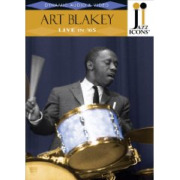
Art Blakey, Live in '65 (Jazz Icons). The Blakey entry in the new Jazz Icons DVD release will come as a surprise even to many of the drummer's most persistent fans. The band it presents in France was not an edition of Blakey's celebrated Jazz Messengers, but a short-lived quintet billed in the opening credits as "Les Art Blakey's New Jazzmen." Assembled for a European tour, it had played a few concerts by the time it appeared at the Palais de la Mutualite as part of the Paris Jazz Festival. The band was primed, collectively and individually.
Rather than a pianist he could count on to operate within his defined rhythmic guidelines, Blakey hired Jaki Byard. As Michael Cuscuna emphasizes in his comprehensive essay, Byard thrived on fluidity of time, a concept that would seem at odds with Blakey's more regimented approach. The bassist is Reginald Workman who could operate with equal effectiveness in Blakey's strict temporal realm and Byard's free one, and it may have been Workman who provided the commonality that made this rhythm section function so well together. The film shows Blakey directing frequent glances and grins of approval at Byard and Workman.
The tenor saxophonist is Nathan Davis, who was living in France at the time and pleased Blakey so well on the tour that the drummer offered him a job when he reformed the Messengers. Davis opted to stay in Paris because of family obligations or he might have become as famous as a number of other Blakey sidemen. Freddie Hubbard came to prominence with Blakey in the early sixties and by 1965 was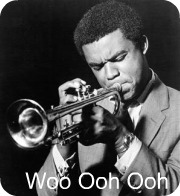 acknowledged as the hottest young trumpet player in jazz. Each of the band's musicians is impressive, but Hubbard owns this concert. He was at the peak of his form in conception, execution and taste. He maintains a stunning level of excellence through each long solo on extended treatments of his compositions "The Hub" and "Crisis" and a brilliant version of "Blue Moon," a signature ballad feature for him during this era. Midway through his virtuoso "Crisis" solo there is a moment emblematic of Hubbard's energy and enthusiasm when he pauses for a breath, executes a deft dance move and, perfectly synchronized, between a grunt and a groan exclaims "Woo, ooh, ooh." Throughout, this was Freddie Hubbard's night.
acknowledged as the hottest young trumpet player in jazz. Each of the band's musicians is impressive, but Hubbard owns this concert. He was at the peak of his form in conception, execution and taste. He maintains a stunning level of excellence through each long solo on extended treatments of his compositions "The Hub" and "Crisis" and a brilliant version of "Blue Moon," a signature ballad feature for him during this era. Midway through his virtuoso "Crisis" solo there is a moment emblematic of Hubbard's energy and enthusiasm when he pauses for a breath, executes a deft dance move and, perfectly synchronized, between a grunt and a groan exclaims "Woo, ooh, ooh." Throughout, this was Freddie Hubbard's night.
Davis had a few worthy albums as a leader and a sideman, but relatively little exposure during his most active playing days. When he returned to the States he concentrated on music education. Since 1969, he has been director of jazz studies at the University of Pittsburgh. He had a generous tone and a fine sense of line in construction of his solos. His work here demonstrates that he was in a class with several tenor players who worked with Blakey over the years. Byard's accompaniments are inspirational to the horn players. His solos are a bit more restrained than they might have been in company with Tony Williams, Alan Dawson or other drummers more inclined to go with his flow. Nonetheless, his mastery of the range of jazz piano styles and his irrepressible cheer and whimsy are in full operation. As for Blakey, he is sui generis, a force of nature, a marvel of swing, one of the great drummer leaders. To see him beaming through his extended solo on "Crisis" is to see a man immersed in his work and in love with it.
The digital remastering of the slightly grainy black and white source film results in acceptable picture and good audio quality. The fourth batch of Jazz Icons DVDs maintains the high standard set by the first three. The series is a boon to listeners and to the preservation of jazz history. Let us hope that its proprietors continue to mine European film and television for more treasures like this one.
Jazz is known all over the world as an American musical art form and that's it. No America, no jazz. I've seen people try to connect it to other countries, for instance to Africa, but it doesn't have a damn thing to do with Africa.
Music washes away the dust of every day life.
AJ Ads
AJ Blogs
AJBlogCentral | rssculture
Terry Teachout on the arts in New York City
Andrew Taylor on the business of arts & culture
rock culture approximately
Laura Collins-Hughes on arts, culture and coverage
Richard Kessler on arts education
Douglas McLennan's blog
Dalouge Smith advocates for the Arts
Art from the American Outback
Chloe Veltman on how culture will save the world
For immediate release: the arts are marketable
No genre is the new genre
David Jays on theatre and dance
Paul Levy measures the Angles
Judith H. Dobrzynski on Culture
John Rockwell on the arts
innovations and impediments in not-for-profit arts
Jan Herman - arts, media & culture with 'tude
dance
Apollinaire Scherr talks about dance
Tobi Tobias on dance et al...
jazz
Howard Mandel's freelance Urban Improvisation
Focus on New Orleans. Jazz and Other Sounds
Doug Ramsey on Jazz and other matters...
media
Jeff Weinstein's Cultural Mixology
Martha Bayles on Film...
classical music
Fresh ideas on building arts communities
Greg Sandow performs a book-in-progress
Harvey Sachs on music, and various digressions
Bruce Brubaker on all things Piano
Kyle Gann on music after the fact
Greg Sandow on the future of Classical Music
Norman Lebrecht on Shifting Sound Worlds
Joe Horowitz on music
publishing
Jerome Weeks on Books
Scott McLemee on books, ideas & trash-culture ephemera
theatre
Wendy Rosenfield: covering drama, onstage and off
visual
Public Art, Public Space
Regina Hackett takes her Art To Go
John Perreault's art diary
Lee Rosenbaum's Cultural Commentary

